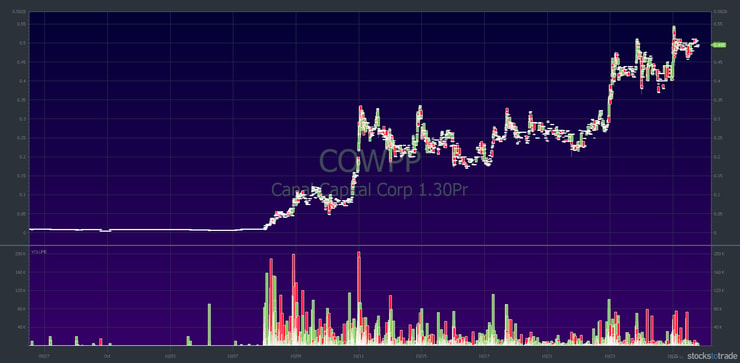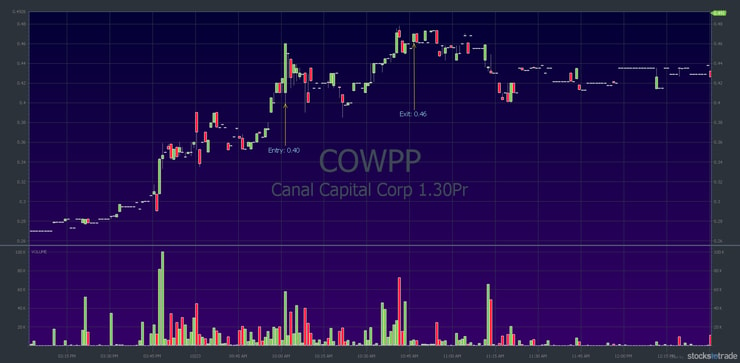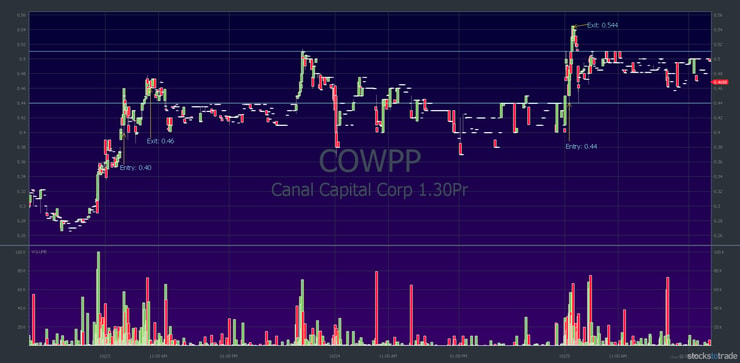The question of trading multiple time frames keeps coming up. Sometimes it’s called multiple time frame analysis. What is it? Let me explain…
A lot of students ask me questions about which charts to look at for a stock. The questions go something like this…
“Do you look at intraday, one-week, or one-month charts?” Or…
“Should I look at long-term and short-term charts?” Or…
“What made you think that would be a support level if there was a morning panic?”
Since the question of time frames and charts comes up often, I’ll feature my two recent COWPP trades as an example. I’ll also answer a question about forcing trades. And another about whether penny stock trading is a black hole of need-to-know information.
First, I want to talk a little about why I travel…
Table of Contents
Statistics Don’t Lie
I mentioned in this post about recent OTC runners that I am, statistically, a better trader when I travel. The funny thing is, just before I was about to post that one on the blog, somebody asked me a question in my webinar. The question was something about trading from 8 a.m. to 5 p.m. — and how much money I could make if that’s all I did.
The reality is I’d probably be worse. Because you can’t force the best setups every day. I know a lot of people who work every single day … non-stop … and they make 20 to 30 trades a day. And maybe they’re profitable on half, or two thirds. But it’s a grind.

My strategy doesn’t require that kind of grind. More importantly…
It suits my dream life.
I think everybody should focus on this question:
What is my dream life?
Then build your trading around that. I describe how I figured this out for myself in my bestselling book. Get a free copy of “An American Hedge Fund” here.
Bali Is Beautiful — But It’s Also Good for Me as a Trader
Bali has — once again — been amazing. As I mentioned in the last update, we opened several new schools. We also just announced a donation of $40,000 for more schools and school buses.
I’m honored to be able to do charity work — it’s my passion. But there are also other benefits to traveling.
When I’m in all these amazing countries I meet new people. I work on charities, try new foods, and have new experiences. I get to learn about new cultures and religions … it’s fascinating. And because it’s so fascinating I don’t wanna trade that much.
That mentality helps me be patient and wait for only the best trades.
Penny Stock Patience Pays Off
I haven’t been trading that much. Yes, I’m still trading — always. But there haven’t been that many great setups for me lately.
We’ve seen a lot of supernovas — which I wrote about in this post. But there were almost too many. And they weren’t due to a hot sector. Everyone was just buying anything that was up. I get scared.
Probably the best lesson of the last week is … there won’t always be a perfect play every single week. And even if there are a lot of plays spiking, you’ve gotta find what you’re good at. If you’re new to penny stocks or for a refresher, get my FREE penny stock course here.
Which brings me back to the trades of the week…
Trades of the Week
I wrote about the first of these two trades in this post. It was an $879 win** even though I had to step away from my laptop. But more important for this post: it’s a great example of trading multiple time frames.
Canal Capital Corporation (OTCPK: COWPP)
The first trade was really a nice multi-month, multiday, and intraday breakout. So three big breakouts — in multiple time frames — at once.
Just as a reminder, I bought COWPP because it’s a recent runner and it was breaking out. But it was also moving very quickly. My goal was to make 10%–20%. It worked out well because, as I said, I had to step away from the computer.
First, look at the COWPP one-month chart:

Notice the breakout on October 23 was a multi-week/multi-day breakout. (Click on the image to open full size in another tab.) Now take a look at the chart showing my entry and exit on the first trade…

As you can see, a few minutes before my trade got executed it was an intraday high-of-day breakout. It was moving very fast. It was a nice little win. I didn’t get greedy — instead taking my 15% while also getting some good charity work done.
FREE Video Lesson Explaining My October 23 COWPP Trade
Check out this video for more detail about the trade using multiple time frame analysis. I talk about my retired trader mentality, too:
Now for my latest COWPP trade…
On October 25 I traded COWPP again. I called it on my watchlist saying it was a potential re-buy for me because it was still a multi-day/multi-week runner AND it had the best looking chart of all the stocks on my list.
SUBSCRIBE to my FREE weekly stock watchlist here.
Take a look at the chart showing both trades:

I only managed to get partial execution during my live Trading Challenge webinar, buying the dip on the morning spike. My goal was to make 10%–20% on it. Again, it moves quick but my entry and exit were about as good as it gets.
I’m often asked about brokers when I only get partial execution. Sometimes it happens when a stock is moving as fast as COWPP. That’s part of the game and even though I wanted a bigger position, I was happy to get some. So to answer the frequent question, I use these brokers.
A Beautiful Multiple Time Frame Technical Breakout
It was a beautiful technical breakout that turned into a fakeout breakout. But I was able to capitalize because I didn’t chase. Instead, I bought the dip near support at $0.44 and sold into strength. The top horizontal line shows the resistance level of $0.51. It was both the previous day’s high and the high-of-day on the morning spike.
Because I bought the dip, I was prepared to sell lower than $0.51 if it couldn’t break out. As it turned out, I actually sold the top for once. It was nothing huge — a $520 win — but a well-planned and executed trade.
Both COWPP trades are an example of multiple time-frame trading. When I’m considering a trade I look at, and analyze, multiple time frames. It doesn’t take long, especially if you use my preferred scanning software, StocksToTrade.
I don’t draw a bunch of lines on the charts like some traders. That’s my personal preference. But I do look at the charts to determine support and resistance. And if it’s an OTC stock, I pay close attention to level 2. That helps me understand supply and demand at any given price.
These two trades are examples of patterns I’ve been teaching for over a decade. To learn the patterns, chart analysis, and my rules please read “The Complete Penny Stock Course.” (For example, Chapter II.5 is Technical Analysis and Price Action. Breakouts are covered starting on page 150. Dips and bounces on page 156. Get the book. Read it!)
One More Thought on Trading Multiple Time Frames
Another way of looking at multiple time frames is this…
Some people trade using different strategies. Again, you have to find what works best for you. So I have students who sometimes swing trade stocks like COWPP. Like this Profit.ly user who was trading COWPP at the same time as me on October 25. But focused on a completely different trading strategy.
09:41 AM Frenchie: I’m still in $COWPP @.29 ….been watching paint dry for two days. Up 68%
09:46 AM Frenchie out $COWPP $1903.54.
Again, that’s not my type of trade because I don’t have the patience and I trade scared. But it’s awesome when students figure out what works for them. Congratulations on that trade, Frenchie!
And now for some…
Student Questions
The first student question is about forcing trades…
“In your experience, is it more common to force trades after several days in a row of hot plays?”
I think newbies force trades all the time. After hot runs and bad runs. Even if they’re just bored.
Even my UNRG trades (see the video above)…
I forced the losing trade because it had the news that was rumored the day before. And I profited from the rumor. So I thought I could profit more from the news. It turned out to be a buy the rumor, sell the news situation.
So I was right about the news…
But I lost overall between the two trades because I didn’t respect one of my own rules: buy the rumor, sell the news. (I trade with these rules.) I did cut losses quickly and managed to make back my losses on my next trade. And then with the second COWPP trade I made even more. But it’s easy to get sucked into forcing trades or over trading. You’ve really gotta be careful.
“When you started, did you go through periods where every time you learned something new it opened a whole new layer of ‘need to know’ information?”
There’s an old saying…
The more you know, the more you realize you don’t know.
Luckily, with penny stocks it’s not like that. It’s not like a black hole where it just keeps getting more and more complex. This is pretty much the simplest niche in finance.
I think it’s more like this…
There are a few catalysts and a few indicators. Seven to be exact — not just one or two. And they’re all in my Trader Checklist guide. But you have to learn them and you have to use them.
Going back to the UNRG trades in the video above, when I bought the rumor and profited that was cool. But I was disappointed it didn’t spike more. Then when I got the news I thought this is the big spike. I totally forgot my rule: buy the rumor, sell the news.
I say it all the time. But in my excitement I forgot. Luckily I cut losses quickly. Sometimes you have to be reminded by the market. Either you learn, or the market will remind you. Eventually, you’ll start to develop a framework. You can still screw up like I did on UNRG. And it’s OK as long as you learn and then screw up less and less.
So if it feels like every new thing you learn opens up more you need to learn … don’t worry. I’ve always said trading is front loaded when it comes to learning. But it’s not endless. Keep at it, study every day, watch every video lesson and all my DVDs and eventually you’ll have the knowledge. But then you’ve gotta gain experience and be meticulous.
Don’t let a small mistake turn into a big disaster.
Millionaire Mentor Market Wrap
In this week’s update I covered trading/analyzing different time frames, forcing trades, and building your knowledge base. Study these lessons again if they’re not clear.
To access 6,000+ video lessons, subscribe to Pennystocking Silver. (Plus, you’ll get my daily watchlists and real-time alerts so you can learn my thought process.)
When you’re ready for my full immersion course, apply for Trading Challenge here.
What Students Are Saying
Below are comments from students during and after my COWPP trade during my live Trading Challenge webinar on October 25…
09:43 AM SeanLacap: timothysykes Nice dip buy on $COWPP.
09:46 AM Maui2020: timothysykes Awesome trade Tim!!
09:47 AM millerruth23: timothysykes nice trade! way to show us emotion, discipline, and patience.
09:48 AM CrazyWillows: timothysykes YES.
09:48 AM SurfinWaves: timothysykes Thanks. That makes sense.
09:48 AM gjbailey36: Yes. Was a nice trade.
09:48 AM _Stitch_: timothysykes Yes sir.
09:48 AM PaulaNYC: timothysykes Makes sense, thanks!
09:48 AM anthquad: timothysykes big eye opener thx tim.
09:48 AM RPhTrader: Makes sense. buy on dip, don’t chase.
09:48 AM oilz_well: timothysykes Lesson learned/reinforced.
I don’t include those comments to brag, but to show you how powerful it is to watch a well-executed trade, in real time, while I explain exactly what I’m doing.
From the TimAlerts Chat Room
Here are a few from the TimAlerts chat room from Profit.ly user Anigai:
09:33 AM Anigai: $COWPP Out the gate quickly. I’d rather wait a little for a HOD to establish and see if can punch through it.
And these after I alerted my trade:
09:39 AM Anigai: Can’t buy $COWPP now. I risk being biased and not learning correctly from Tim’s example.
09:44 AM Anigai: I would think a ‘how far can it go’ mentality on $COWPP is wrong from my studies, a get out target should be established. I’m very interested in the lessons of Tim’s trade here.
09:47 AM Anigai: Lots of lessons on $COWPP to dissect for me. My knowledge account is certainly green on the day already.
Anigai didn’t have the benefit of hearing me live on the webinar. But as you can see Anigai is analyzing the trade to figure out my process. That’s what it takes — study and build your knowledge account over time.
Student Tweets
Here’s one from @StevenT60511933:
I am ready. Up at 5 am every trade day. Cowpp good to me yesterday bought at .44 sold to soon at .4715. Still made a profit.
— Steven Taylor (@StevenT60511933) October 24, 2019
I like this one from @Chesskid90:
so i just sold my dip buy this am at .34 at .472 on $COWPP just now, likely goes higher but i took my single and now can live life @timothysykes especially bcuz i actually have tonight off from my day job yay
— Sean Riddell (@Chesskid90) October 23, 2019
[Please note these results are not typical. These traders have exceptional knowledge and skills that they’ve developed with time and dedication. Most traders lose money. Trading is risky. Do your due diligence and never risk more than you can afford.]
What do you think of this week’s update? Comment below, I love to hear from all my readers!





Leave a reply